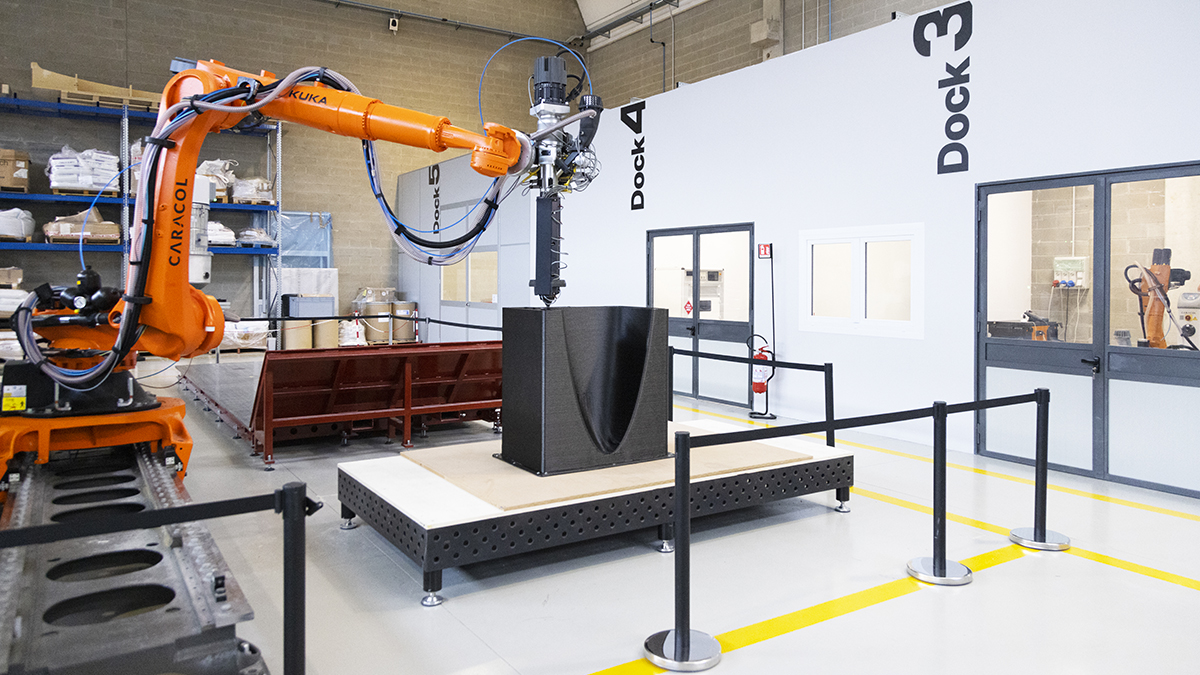
Revolutionizing Autoclave Mold Production: Impact and Benefits of Large Format 3D Printing
In the realm of advanced manufacturing, the integration of large-format 3D printing continues to redefine traditional processes. This has become increasingly true for tooling, jigs, fixtures, and molds, and it is broadly happening with autoclave molds, which play a crucial role in the production of composite components widely used in aerospace, automotive, and other high-performance industries. This groundbreaking approach is revolutionizing the way molds are created, offering a range of benefits that significantly impact efficiency, cost-effectiveness, and design flexibility.
In this scenario, Caracol joined forces with Connova and Formbar to introduce LFAM technology within Connova’s production workflow for composite parts, such as a drone nose. With the LFAM platform, Heron AM, Caracol 3D printed the mold for pre-preg autoclave lamination of this carbon fiber component. Starting from the 3D file provided by Connova, Caracol’s application engineers worked to optimize the part for Additive Manufacturing production and define the best slicing strategy. Heron AM 400, equipped with Caracol’s High Flow (HF) extrusion head printed two monolithic parts, weighing 130 kg each, in 15 hours per part. Through the extrusion of a highly-performing composite material such as DAHLTRAM C-250 CF (carbon fiber-filled polycarbonate), the mold can withstand high-temperature autoclave processes of about 135°C and a pressure of 6 bar.
Following production of the mold, the tool-side surface was mechanically machined by Formbar, using a 5-axis CNC to guarantee aerospace requirements and tolerances, achieving a 0.8 μm surface roughness, and 0.1 mm dimensional tolerance. By collaborating the our Design and Engineering team, the company worked to achieve optimal alignment between CAD and printed part. The post-processing phase completed the production cycle, seamlessly delivering the mold ready to use to composite specialists at Connova Group to manufacture the component using the prepreg/autoclave process.
The carbon fiber drone nose was the very first component manufactured by Connova Group from a 3D printed mold, which assessed the effectiveness and real benefits of Caracol’s LFAM technology as part of its advanced manufacturing processes.
Key Production Facts:
- TECHNOLOGY: LFAM Heron AM with HF extruder + CNC post-processing
- MATERIAL: DAHLTRAM C-250 CF (PC 20CF)
- SIZE AND WEIGHT: 1100 x 1100 x 900 mm, 260 Kg/piece
- 3D PRINTING NOZZLE SIZE: 12 mm
- 3D PRINTING TIME: 30 hours
Key advantages compared to traditional manufacturing
By using Caracol large-scale 3D printer Heron AM 400 HF, the production and supply chain of Connova aerospace lamination mold benefit from several advantages, such as:
- WEIGHT REDUCTION: 50%
- WASTE REDUCTION: 40%
- LEAD TIME REDUCTION: 50 %
- COSTS SAVED: 30%
- PROCESS OPTIMIZATION: only one monolithic piece cycle, avoiding manual work as gluing resin boards or blocks.
01. Heron AM 400 HF 3D prints an autoclave mold for carbon fiber lamination of a drone nose structure
02. Drone nose structure laminated through autoclave method with 3D printed mold
What benefits does LFAM provide in autoclave tool production?
Autoclave molds are traditionally produced with labor-intensive processes such as CNC machining or manual tooling. Leveraging large-format additive Manufacturing to produce complex molds with unprecedented precision and speed, offers a range of benefits that significantly impact efficiency, cost-effectiveness, and design flexibility.
Substantial reduction in lead times that impacts efficiency and time-to-market. Traditional mold-making methods can be time-consuming, often requiring weeks or even months to complete. With large-format 3D printing, intricate molds can be produced in a matter of days, allowing manufacturers to accelerate their product development cycles and respond more rapidly to market demands.
Sustainable production with close-to-zero waste. The additive nature of 3D printing minimizes material waste, as the process only utilizes the necessary amount of material for the final product. This sustainable approach contributes to environmental conservation while further optimizing production efficiency.
Cost-Effectiveness and Resource Optimization. Large-format 3D printing for autoclave mold production has the potential to significantly reduce costs associated with tooling. Traditional methods often involve expensive machinery, skilled labor, and extensive post-processing steps. In contrast, 3D printing allows for the creation of intricate molds in a single, automated process, minimizing the need for manual intervention and reducing the cost of machining equipment, only needed for finishing before the final use of the piece.
Long-term effectiveness and cost savings. Large-scale molds can be 3D printed in a single piece, eliminating the need for assembly and reducing the risk of structural weaknesses that may arise from joining multiple components. This results in more robust, durable molds that contribute to long-term cost savings.
Design Flexibility and Iterative Prototyping. The flexibility afforded by large-format 3D printing enables designers and engineers to explore complex geometries and iterate rapidly on mold designs. This freedom to experiment with shapes, undercuts, and internal features allows for the creation of molds that were previously deemed impractical or cost-prohibitive. As a result, manufacturers can push the boundaries of design, optimizing parts for performance while maintaining structural integrity. The iterative prototyping capabilities of large-format 3D printing also facilitate a more agile product development process. Designers can quickly test and refine mold designs based on real-world performance, leading to higher-quality final products and reduced development risks.
In conclusion, Large-Format 3D printing is reshaping the landscape of autoclave mold production, offering a range of benefits that extend beyond efficiency and cost-effectiveness. The project developed with Connova and Formbar is a tangible case of LFAM’s capability to empower manufacturers to push the boundaries of innovation while reducing time-to-market. As the manufacturing industry continues to embrace additive manufacturing, Caracol’s services and technologies in large format 3D printing of advanced materials aim at becoming a cornerstone in the evolution of autoclave mold production, driving advancements in performance, sustainability, and overall competitiveness.



























